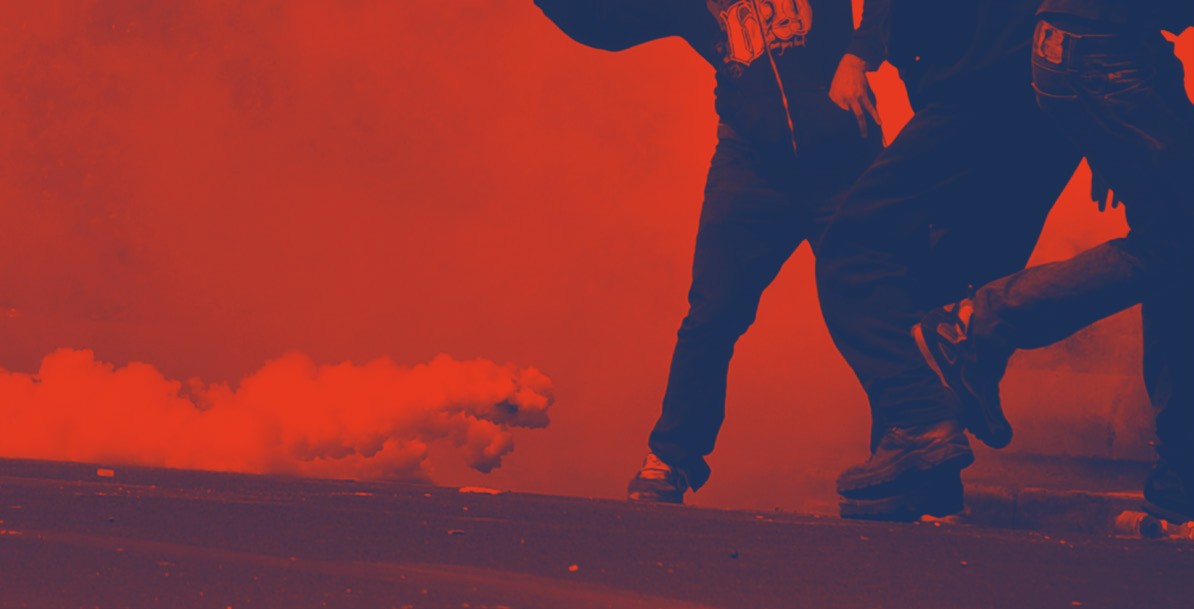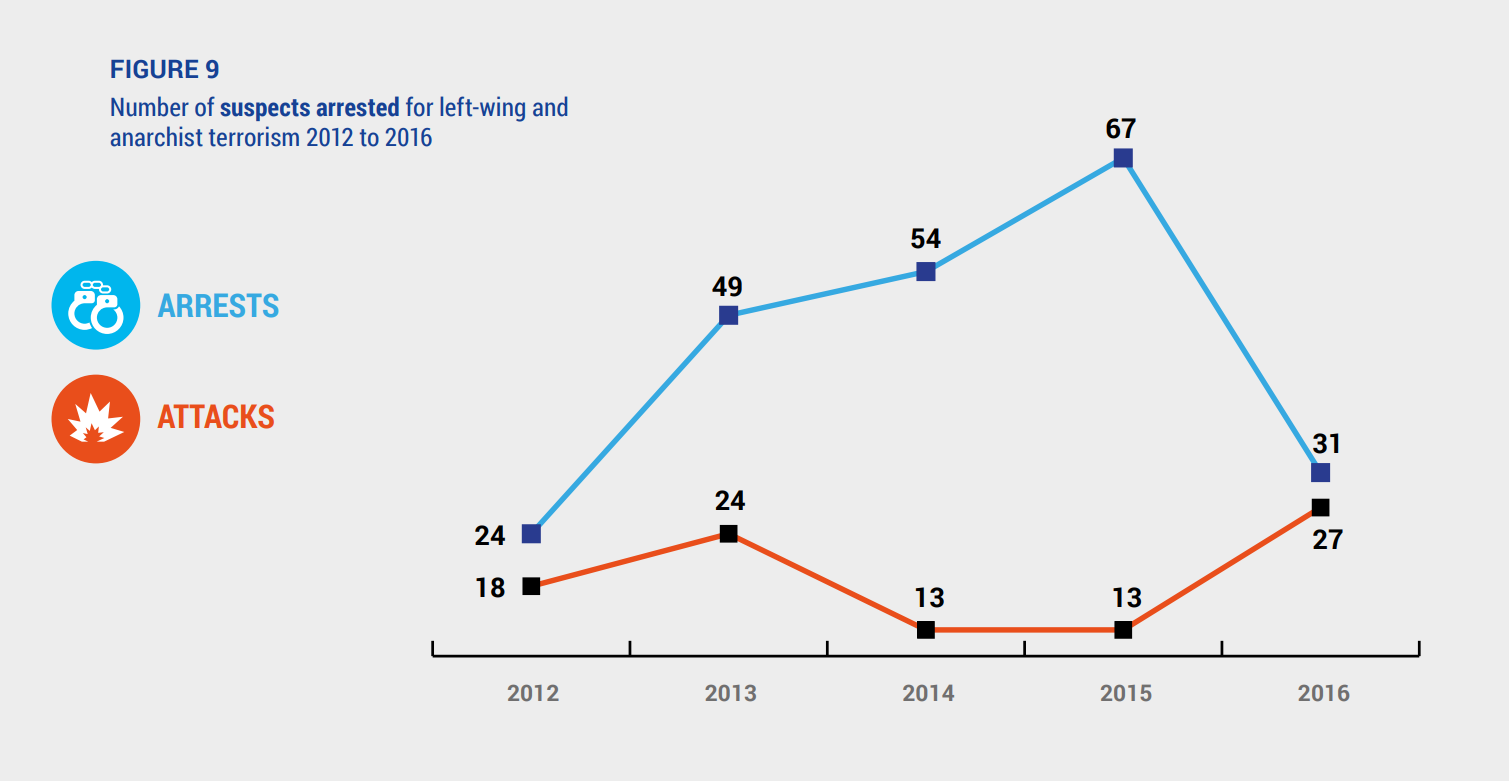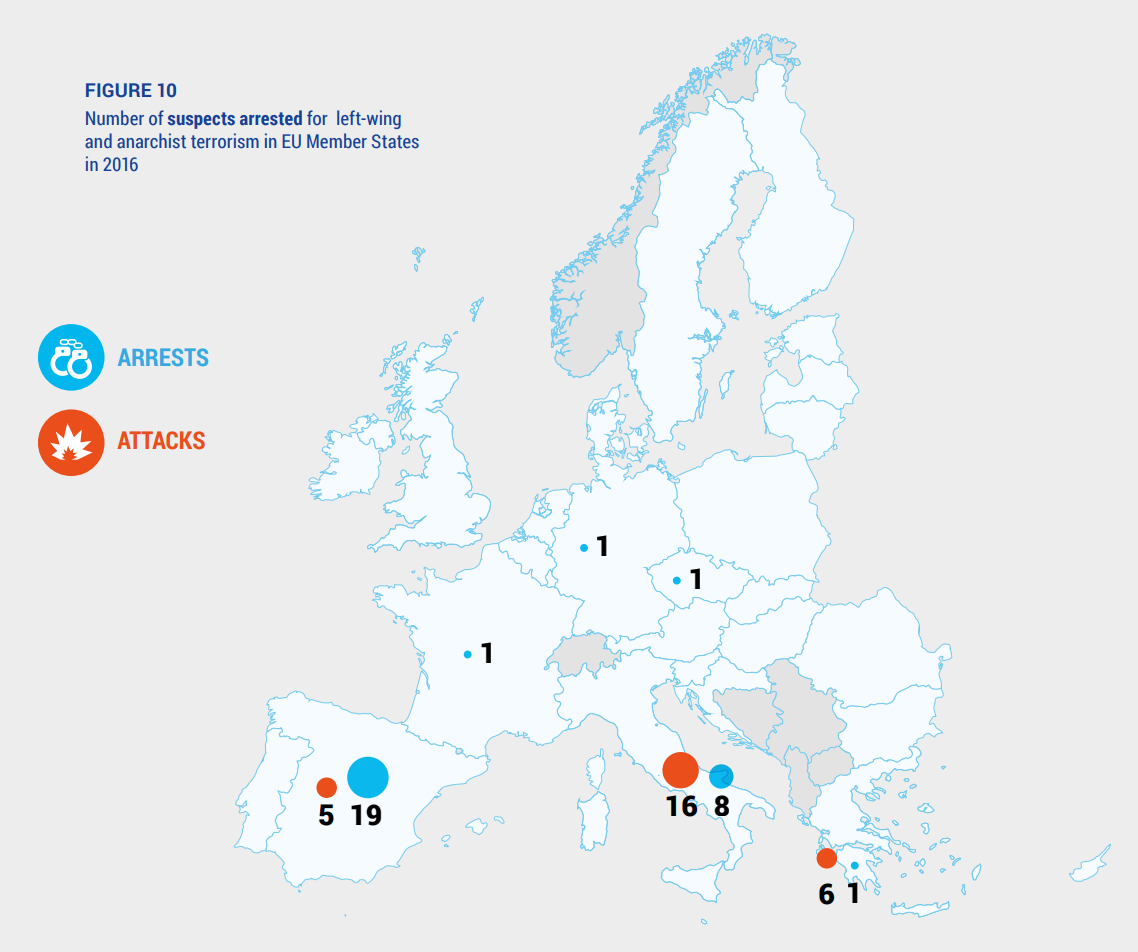Terrorist attacks and suspects arrested
In 2016, left-wing and anarchist terrorist groups or individuals in the EU carried out 27 attacks. This was a sharp increase, compared to the number of attacks that occurred in 2015. EU Member State authorities arrested 31 people related to left-wing and anarchist terrorism in 2016, most of them in Spain.
Italy, Greece and Spain were again the only EU Member States to experience left-wing and anarchist terrorist attacks. Over the past two decades, anarchist terrorist groups in these three countries have developed similar characteristics, used the same modi operandi and endorsed similar agendas. In 2016, there were no coordinated terrorist campaigns across the three countries. However, it is assessed that some attacks in Italy were carried out in response to a call for action by imprisoned anarchist terrorists in Greece.
In Italy in 2016, a total of 16 attacks were carried out by leftwing and anarchist terrorist groups. Although the incidents increased in number compared to 2015, it appeared that the operational capabilities of the groups remained low.
The majority of the attacks in 2016 were carried out using unsophisticated improvised incendiary/explosive devices (IID/IEDs), containing flammable liquids or gunpowder and crude ignition mechanisms, some of which failed to operate. Eight people were arrested on charges related to left-wing and anarchist terrorism.
Italian anarchist terrorist groups targeted facilities related to the management of migration-related issues in general; and to the function of the Identification and Deportation Centres (CIE) in particular. Five victim-operated improvised explosive devices (VOIEDs, parcel bombs) were sent between February and September to travel agencies and companies related to the CIEs, without causing injuries or damage.
Italy also experienced the re-emergence of Federazione Anarchica Informale/Fronte Rivoluzionario Internazionale (FAI/ FRI, Informal Anarchist Federation/International Revolutionary Front). In January for example, its Pyrotechnical Committee for an Extraordinary Year cell placed an IID outside the Courthouse of Civitavecchia in Rome, causing damage. In June, two VOIEDs were sent by the Danaus Plexippus FAI/ FRI cell: one was addressed to the European Food Safety Authority in Parma and was detected by security personnel; the other was sent to a private biotechnology company and caused minor injuries to the firm’s owner. A FAI/FRI cell is also believed to have placed an IED outside a Carabinieri Station in Bologna that caused damage to the building.
In Greece, it appears that left-wing and anarchist terrorist groups have retained their operational capabilities as well as their access to weapons. In 2016 they carried out six attacks involving the use of IEDs, firearms and grenades. In October, Synomosia Pyirnon tis Fotias (Conspiracy Cells of Fire) placed an IED outside the residence of a prosecutor in Athens. The powerful explosion caused significant damage. The Organosi Epanastatikis Aftoamynas (Revolutionary Self-Defence Organisation) adopted a more international scope in its attacks. It targeted two foreign embassies in Athens: in July, its members carried out a drive-by shooting against the Embassy of Mexico and caused minor damage to the building; in November, they threw a hand grenade at the Embassy of France, slightly injuring the police officer guarding the premises.
In Spain, left-wing and anarchist terrorist activities remained at low levels. Five attacks occurred in 2016 but did not involve extensive operational planning or the use of sophisticated IEDs or firearms. Notwithstanding this, 19 people were arrested in relation to left-wing and anarchist terrorism. The number of arrests in the country has remained consistently high, with a total of 100 people arrested since 2013. This has apparently had an impact on operational capabilities, mainly of the anarchist terrorist groups, causing a decrease in the number of attacks over the same period of time.
Of interest is that members of Spanish extremist groups adhering to communist ideologies joined Kurdish militias in Syria and Iraq, and were actively involved in combat activities against the so-called Islamic State (IS). It remains to be seen how their participation in the conflict will affect their activities on Spanish soil.
Marxist-Leninist terrorist groups in the EU have ceased to be operational and limit their activities to propaganda. However, the Turkish Devrimci Halk Kutrulus Partisi/Cephesi (DHKP/C, Revolutionary People’s Liberation Party/Front) remained active in Turkey and carried out five attacks, targeting police, judicial and government employees. The DHKP/C has never conducted attacks in the EU but retains a network in several EU Member States that provides financial and logistical support to operatives in Turkey. Its structures in the EU operate partially under the cover of legally established associations. In 2016, one Dutch citizen was arrested in Germany on charges of terrorism financing connected to the DHKP/C.





